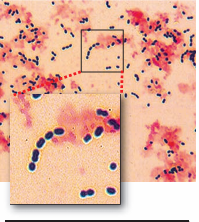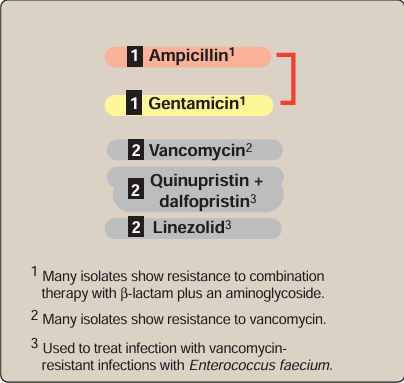
Enterococci
 المؤلف:
Cornelissen, C. N., Harvey, R. A., & Fisher, B. D
المؤلف:
Cornelissen, C. N., Harvey, R. A., & Fisher, B. D
 المصدر:
Lippincott Illustrated Reviews Microbiology
المصدر:
Lippincott Illustrated Reviews Microbiology
 الجزء والصفحة:
3rd edition , p87-88
الجزء والصفحة:
3rd edition , p87-88
 2025-01-21
2025-01-21
 855
855
Enterococci contain a C-substance that reacts with group D anti sera. Therefore, in the past, they were considered group D streptococci. Today, DNA analysis and other properties have placed them in their own genus, Enterococcus. The clinically most important species are E. faecalis and E. faecium. Enterococci can be α-, β-, or nonhemolytic. As a rule, enterococci are not very virulent, but they have become prominent as a cause of nosocomial infections as a result of their multiple antibiotic resistance. Figure1 shows the microscopic appearance of E. faecalis.

Fig1. Enterococcus fecalis showing chain formation characteristic of Streptococcus.
A. Epidemiology
Enterococci are part of the normal fecal flora. However, they can also colonize oral mucous membranes and skin, especially in hospital settings. These organisms are highly resistant to environmental and chemical agents and can persist on fomites. B. Diseases Enterococci seldom cause disease in normal, healthy individuals. However, under conditions in which host resistance is lowered or the integrity of the gastrointestinal or genitourinary tract has been disrupted (for example, by instrumentation), enterococci can spread to normally sterile sites, causing urinary tract infections, bacteremia/sepsis, endocarditis, biliary tract infection, or intra-abdominal abscesses.
C. Laboratory identification
Enterococci are distinguished from the non–group D streptococci by their ability to survive in the presence of bile, and to hydrolyze the polysaccharide esculin, producing black colonies on esculin-containing plates. Unlike nonenterococcal group D streptococci, enterococci grow in 6.5 percent NaCl, and yield a positive pyrazin amidase (PYR) test. E. faecalis can be distinguished from E. faecium by their fermentation patterns, which are commonly evaluated in clinical lab oratories
D. Treatment
Enterococci are naturally resistant to β-lactam antibiotics and aminoglycosides, but are sensitive to the synergistic action of a combination of these classes. In the past, the initial regimens of choice were penicillin +/– streptomycin or ampicillin +/– gentamicin (Figure 2). However, acquired resistance determinants in many current strains negate this synergy. In addition, isolates frequently have natural or acquired resistances to many other antibiotic classes, including glycopeptides such as vancomycin. Newer antibiotics, such as the combination of quinupristin and dalfopristin, are used to treat vancomycin-resistant infections. However, some enterococcal strains are resistant to all commercially available anti biotics. [Note: E. faecium is more likely to be vancomycin or multiply resistant than E. faecalis.]

Fig2. Antimicrobial agents useful in treating infections caused by enterococci.
E. Prevention
The rise of nosocomial infections by multiple drug –resistant enterococci is largely the result of selection due to high antibiotic usage in hospitals. Judicious use of antibiotics is an important factor in con trolling the emergence of these infections
 الاكثر قراءة في البكتيريا
الاكثر قراءة في البكتيريا
 اخر الاخبار
اخر الاخبار
اخبار العتبة العباسية المقدسة


